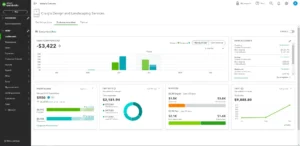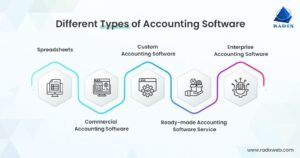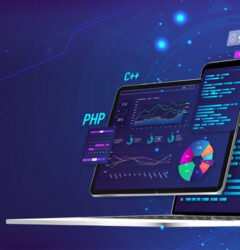Accounting Software
Accounting software is designed to manage and streamline financial tasks for individuals, businesses, and organizations. It automates tasks like bookkeeping, invoicing, payroll, and financial reporting, allowing users to track expenses, generate statements, and monitor cash flow. Here’s an overview of common features and benefits:

Accounting Software Features
- General Ledger Management: Records all transactions, including income, expenses, assets, and liabilities.General Ledger (GL) management is the foundation of any accounting system, capturing and organizing a company’s financial data. The general ledger records every financial transaction across accounts, creating a comprehensive view of all assets, liabilities, equity, income, and expenses.
- Accounts Payable and Receivable: Manages bills, tracks invoices, and follows up on payments.Accounts Payable (AP) and Accounts Receivable (AR) are key components of financial management. AP tracks money a business owes to suppliers and vendors, helping ensure timely payments and good credit standing. AR, on the other hand, monitors incoming payments from customers, managing invoices and collections to maintain steady cash flow. Together, AP and AR provide insights into a company’s financial health, enabling better budgeting and cash management. Effective AP and AR processes ensure a company meets its obligations while optimizing incoming funds, reducing the risk of cash shortfalls.
- Bank Reconciliation: Matches transactions with bank statements to ensure accuracy.Accounts Payable (AP) and Accounts Receivable (AR) are key components of financial management. AP tracks money a business owes to suppliers and vendors, helping ensure timely payments and good credit standing. AR, on the other hand, monitors incoming payments from customers, managing invoices and collections to maintain steady cash flow. Together, AP and AR provide insights into a company’s financial health, enabling better budgeting and cash management. Effective AP and AR processes ensure a company meets its obligations while optimizing incoming funds, reducing the risk of cash shortfalls.
- Expense Tracking: Records expenses and categorizes them for budgeting and analysis.Expense tracking involves recording and categorizing a company’s expenses to monitor spending and manage budgets effectively. This process includes capturing all costs—from small operational expenses to significant purchases—using methods like expense reports, digital receipts, and software tools. By tracking expenses accurately, businesses can analyze spending patterns, identify cost-saving opportunities, and ensure they stay within budget. Expense tracking also supports compliance with tax regulations by maintaining organized records for deductions and audits. Through effective expense tracking, companies gain valuable insights into their financial health and improve decision-making around resource allocation.
- Financial Reporting: Generates reports like profit and loss statements, balance sheets, and cash flow reports.Financial reporting is the process of compiling and presenting an organization’s financial data to stakeholders, typically through standardized statements like the balance sheet, income statement, and cash flow statement. These reports provide insights into a company’s financial performance, position, and cash flow, aiding stakeholders in making informed decisions. Financial reporting is essential for assessing profitability, liquidity, and solvency, and it supports transparency and accountability within an organization. It also ensures compliance with regulatory standards, which vary by jurisdiction, helping businesses avoid legal issues and maintain trust with investors, creditors, and customers.
- Payroll Processing: Automates payroll tasks, calculates taxes, and generates pay stubs.Payroll processing is the administration of employee wages, benefits, and deductions, ensuring that staff are accurately compensated on time. This process involves calculating hours worked, applying tax withholdings, deducting benefits, and issuing payments. Payroll processing software or services streamline these tasks by automating calculations, managing tax filings, and generating pay stubs, reducing the risk of errors and ensuring compliance with tax and labor laws. Efficient payroll processing enhances employee satisfaction by ensuring timely and accurate payments and helps businesses maintain accurate financial records, supporting overall financial management and regulatory compliance.
- Inventory Management: Tracks inventory levels, orders, and product costs for businesses dealing with physical goods.Inventory management is the systematic approach to ordering, storing, tracking, and controlling a company’s inventory—whether raw materials, components, or finished products. This process ensures that the right quantity of inventory is available at the right time to meet demand without overstocking or stockouts. Inventory management software automates tracking, updates stock levels in real-time, and can forecast future inventory needs based on sales trends and historical data. Effective inventory management optimizes storage costs, improves cash flow, and helps companies meet customer demand efficiently, playing a critical role in supply chain management and overall profitability.
- Tax Management: Helps manage tax compliance, calculate deductions, and generate tax reports.Tax management is the process of handling a business’s tax obligations in a strategic and compliant way, ensuring accurate calculation, reporting, and payment of taxes. This includes tracking deductible expenses, filing tax returns, managing payroll taxes, and adhering to regulatory changes that impact tax rates or requirements. Effective tax management minimizes the risk of errors, penalties, or audits, and can identify potential tax-saving opportunities through deductions or credits. By using tax management software or consulting with tax professionals, businesses can stay organized and compliant, supporting long-term financial health and transparency.
- Budgeting and Forecasting: Provides insights into future cash flows and helps set financial goals.Budgeting and forecasting are financial planning tools that help businesses set goals, allocate resources, and prepare for future financial scenarios. Budgeting involves creating a detailed plan of expected revenues and expenses over a specific period, typically based on historical data and strategic priorities. Forecasting, on the other hand, is an ongoing process of predicting future financial outcomes, often updated with current trends and market conditions to refine expectations. Together, budgeting and forecasting help businesses manage cash flow, make informed investment decisions, and quickly adapt to changing conditions, providing a roadmap to achieve financial objectives and maintain stability.

Accounting Software Key Features
- General Ledger Management: Records all transactions, including income, expenses, assets, and liabilities.
- Accounts Payable and Receivable: Manages bills, tracks invoices, and follows up on payments.
- Bank Reconciliation: Matches transactions with bank statements to ensure accuracy.
- Expense Tracking: Records expenses and categorizes them for budgeting and analysis.
- Financial Reporting: Generates reports like profit and loss statements, balance sheets, and cash flow reports.
- Payroll Processing: Automates payroll tasks, calculates taxes, and generates pay stubs.
- Inventory Management: Tracks inventory levels, orders, and product costs for businesses dealing with physical goods.
- Tax Management: Helps manage tax compliance, calculate deductions, and generate tax reports.
- Budgeting and Forecasting: Provides insights into future cash flows and helps set financial goals.

-
Accounting Software Right the Choosing
When choosing accounting software, consider factors like ease of use, industry-specific needs, integration capabilities with other software, and available support and training. Whether you’re a small business, freelancer, or a large organization, the right accounting software can simplify your financial management and help you stay on top of your finances.

-
List of Blogs
-


